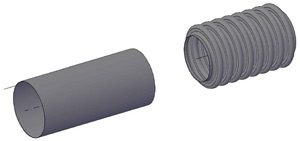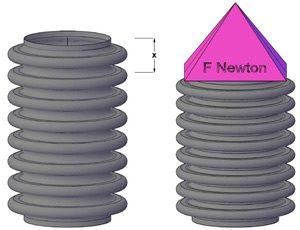Technical Information
- Home
- /
- Technical Information
-
Pressure Thrust and Instability
of Metal Bellows Expansion Joints or
Compensators -
Spring Rate and Spring Force of
Metal Bellows Expansion Joints
Compensators. -
Cyclic or fatigue Life of
Metal Bellows Expansion Joints - Bellows Components and Accessories.
- Frequently Asked Questions.
- Our Link Resources.
Different movements of Metal Bellows
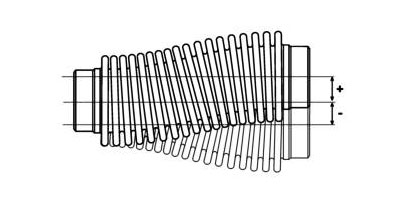
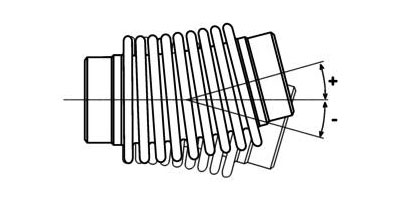
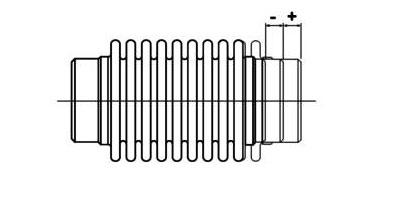
Different movements of Metal Bellows



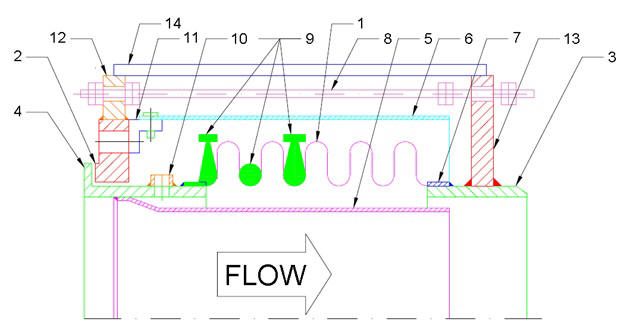
When the bellows is formed to cover the flange front face or the bellows attachment is flared so as to cover the front surface of the flange keeping it free to rotate then end is called as Vanstone end. The primary functions of the Vanstone end are as below:
- To keep the flowing medium away from contact with flange face.
- To provide easy fitment and bolting of the flanges if mating flanges are already fixed and cannot be rotated to match the hole orientation of the body flanges.
A device which minimizes the contact between inner surface of the bellows portion of the Piping Expansion Joint and the fluid flowing through it . It is also called as Liner.
A liner is used when it is necessary
- To ensure smooth flow of the medium without turbulence at high velocities
- To minimize friction losses
- To minimize resonant vibration caused by high flow velocities
- To reduce the effect of turbulent flow upstream of the expansion joint
- To prevent the erosion of the bellows wall from abrasion or chemical attack
Internal liners or sleeves are provided when flow velocities exceed the following limits
- For water and other liquids
- Up to 150 mm diameter � 500 mm/s
- Over 150 mm diameter- 3 m/
- For air, steam and other gases
- Up to 150 mm diameter �
- 1.2m/s
Over 150 mm diameter- 7.6 m/s
Devices used on some pipe expansion joint fitting snugly in the roots of the convolutions. The primary purpose of these devices is to reinforce the bellows against internal pressure.
Equalizing rings are made of cast iron, steel, stainless steel or other suitable alloys and are approximately �T� shaped in cross section. Reinforcing or root rings are fabricated from tubing or solid round bars of carbon steel, stainless steel or suitable alloys.
These connections usually threaded are provided whenever required are provided at the sealed end of each internal sleeve of the piping expansion joint for the purpose of injecting a liquid or gas between the bellows and internal sleeve to keep the area clear of erosive and corrosive media and or solids that could pack the convolutions affecting the free movement.Purging may be continuous intermittent or just at start-up or shut-down as required.
CONTROL RODS- Devices usually in the form of bars or rods attached to the piping expansion joint assembly whose primary function is to distribute the movement between the two bellows of an universal expansion joint. Control rods are not designed to restrain the bellows pressure thrust and require proper guides and anchors in the pipeline.
TIE RODS- Devices usually in the form of bars or rods attached to the pipe expansion joint assembly whose primary function is to continuously restrain the full bellows pressure thrust during normal operation while permitting only lateral and angular movement. This is accomplished by two tie rods opposite to each other and located in a plain at 90� to the plain of movement.
LIMIT ROODS – Devices usually in the form of bars or rods attached to the piping expansion joint assembly whose primary function is to restrict the bellows movement range (axial, lateral, angular) during normal operation. In the event of main anchor failure they are designed to prevent the over extension or over compression while restraining the full pressure loading and dynamic forces generated by the anchor failure. However they do not restrain the pressure thrust during normal working and require proper guides and anchors in the pipeline.
These are rigid supporting devices usually in the form of brackets of angle or channels to maintain the overall length of the assembly for shipment. These devices may also be used to pre-compress or pre-extend or laterally offset the pipe expansion joints assembly . They should not be used to resist the pressure thrust during hydro-testing and should be removed after complete installation and before hydro-testing of the piping expansion joints.
Different movements of Metal Bellows



